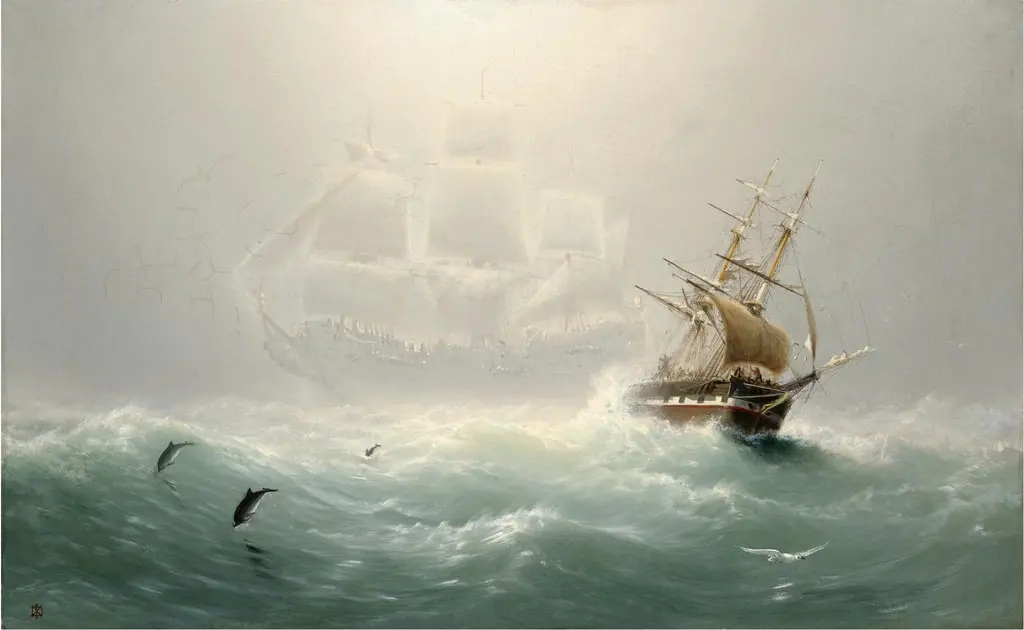The Flying Dutchman

Nautical Nightmares
by Charles Spratley
The crashing of the waves and the salty air remind me of my childhood growing up in San Diego. It also, unfortunately, reminds me of my time working on fishing boats as a young man. The cramped quarters, the long hours working the decks. The sounds and smells of the ocean also acts as a constant reminder of how merciless the ocean is. She gives and takes without any mercy, and sometimes the ships come back. I am, of course, talking about ghost ships. The story of ghost ships has been around for centuries from all parts of the world. A ghost ship is defined as either a paranormal occurrence in which a spectral ship has been spotted but this label has also been given to ships mysteriously found adrift in open water, completely devoid of crew. I find both of these phenomena intriguing and so wanted to cover them both.
The most famous ghost ship of all time is the Flying Dutchman. I never thought I would say thank you to the Pirates of the Caribbean franchise, but for many the Dutchman meant nothing until these films came out. And for sailors, the Dutchman is indeed very real, and feared. The oldest version of this story goes back to the 18th Century. The first time the Flying Dutchman is mentioned is by John MacDonald in 1790 in a book entitled Travels in various part of Europe, Asia and Africa during a series of thirty years and upward:
The weather was so stormy that the sailors said they saw the Flying Dutchman. The common story is that this Dutchman came to the Cape in distress of weather and wanted to get into harbour but could not get a pilot to conduct her and was lost and that ever since in very bad weather her vision appears.
Many more sources tell of the Dutch man-of-war that was lost off the Cape of Good Hope in bad weather and when other ships attempt the treacherous passage in similar conditions, they see the spectral ship in the distance. Sailors of the age speculated that the ghostly ship was caused by the crew themselves, guilty of a horrible crime, damned to sail until their penance is met.
The most famous sighting of the phantom ship was by Prince George of Wales, the prince who will become King George the V. In the 1880s, as a young man, George and his brother were serving onboard the HMS Inconstant, a steel hulled frigate that was the fastest war ship in the world at the time. This from the Prince’s log, dated July 11th, 1881:
July 11th. At 4 a.m. the Flying Dutchman crossed our bows. A strange red light as of a phantom ship all aglow, in the midst of which light the masts, spars and sails of a brig 200 yards distant stood out in strong relief as she came up on the port bow, where also the officer of the watch from the bridge clearly saw her, as did the quarterdeck midshipman, who was sent forward at once to the forecastle; but on arriving there was no vestige nor any sign whatever of any material ship was to be seen either near or right away to the horizon, the night being clear and the sea calm. Thirteen persons altogether saw her … At 10.45 a.m. the ordinary seaman who had this morning reported the Flying Dutchman fell from the foretopmast crosstrees on to the topgallant forecastle and was smashed to atoms.
The Flying Dutchman may be one of the most famous ghost ships but it is hardly the only. On March 6th, 1878, a large Corvette named Eurydice started its three-month voyage from Portsmouth, England to the West Indies. The vessel didn’t get far for it was caught in a storm off the coast of the Isle of Wight, and it was there she capsized and sank. Of the 364 souls on board, only two survived. The others went down with the ship or froze in the stormy waves. One of the witnesses of this tragedy was a young Winston Churchill, whose family was living in the village of Ventor at the time. The ship was refloated the next September, but she was so badly damaged that she was broken up. The ship’s bell is preserved at St Paul’s Church, Gatten. Even the author Sir Arthur Conan Doyle, a known Spiritualist, wrote a poem about her sinking entitled The Homecoming of the Eurydice.
After that, both sailors and visitors have reported seeing a three-mast ship matching the description of the doomed Eurydice with its gun ports open and then suddenly it would disappear from view. In the 1930s, a British submarine under the command of a Captain Lipscomb, reported that they had to make a drastic change in course to prevent striking the ghost ship. Again, under mysterious circumstances, the ship simply vanished.
On October 17th, 1998, Price Edward was filming a show called Crown and Country and he and some members of the film crew claimed to see the famous spectral vessel. Upon seeing it, he reportedly told everyone to wait until it got closer to the shore and then it vanished in the mist. Edward, upon being interviewed about the incident said, “I am quite convinced as far as ghosts are concerned that there are too many stories, coincidences, occurrences and strange happenings. There is something definitely out there, but what it is I don’t really know.”
Of course, no nautical mystery would be complete with the most mysterious disappearance of all time, that of the crew of the Mary Celeste. On October 20, 1872, the Mary Celeste pulled into New York to receive 1,701 barrels of denatured alcohol. A few days later, the ship departed for Genoa, her crew spartan, consisting of only the captain and his wife and daughter and five crew members.
On December4th, the crew of a brigantine named Dei Gratia, also bound for Genoa, spotted a vessel acting erratically under the wind off the coast of Portugal. Signals were sent to the mysterious ship, yet none returned. The captain of the Dei Gratia, David Morehouse, sent two crewmen over to the unresponsive ship for answers. The ship was empty of all crew. It was then that the ship was determined to be the Mary Celeste by the name on her stern. Morehouse became very agitated. He knew the captain of the other vessel well and knew of his cargo and destination. Upon examination, it found the sails and rigging were in poor condition and the main hatch was closed but several small hatches were open. There was some water in the hold, but not an alarming amount for a ship that size. They located the ship’s log in the mate’s cabin and the last entry was 8 days earlier and their noted position then 400 nautical miles from where she was found. There were no signs of violence or any other ill fate of the crew but the sole lifeboat was missing. Morehouse divided his crew into two and his men boarded the Mary Celeste and guided her into Gibraltar, which was 600 nautical miles away.
In Gibraltar, there was a thorough examination done of the derelict ship. There was a theory of murder for they found a stain on one of the rails that may have been blood. There was even a suspicion that Morehouse ambushed the Mary Celeste and murdered the crew. Another theory surrounded the lifeboat. A possibility that the crew abandoned ship thinking the denatured alcohol on board was about to explode, but this was quickly dismissed, the captain was far too experienced to panic and abandon ship under those circumstances. Even the theory of a waterspout was considered yet eventually discarded. And to this day, no one truly knows what happened to the eight people on board the vessel and it will go down in the annals of history as the most famous account of disappearance on the high seas.
- Posted in:
- The Paranormal Library
